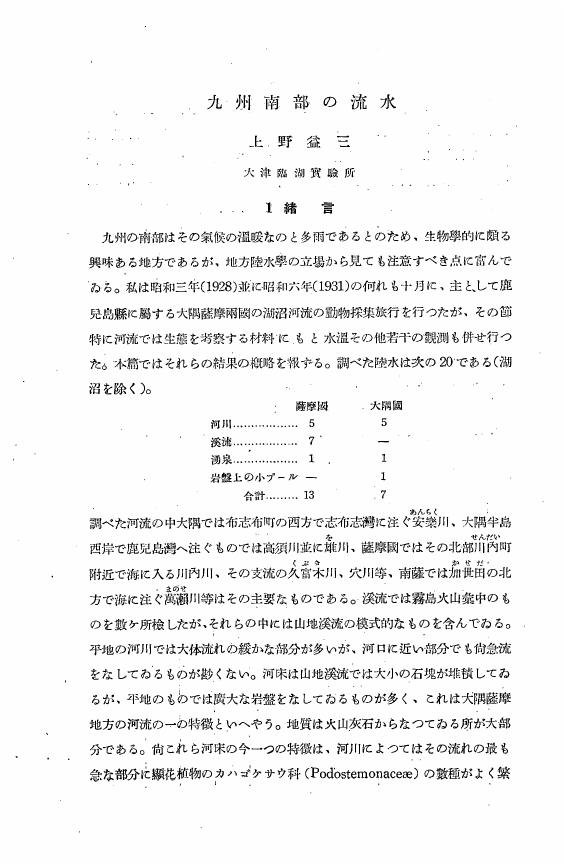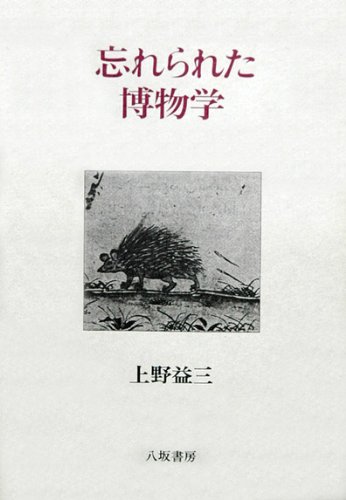7 0 0 0 OA 鷲家口とニホンオオカミ
- 著者
- 上野 益三
- 出版者
- 甲南女子大学
- 雑誌
- 甲南女子大学研究紀要 = Konan Women's College researches (ISSN:03864405)
- 巻号頁・発行日
- no.5, pp.89-108, 1969-03
5 0 0 0 OA 九州南部の流水
- 著者
- 上野 益三
- 出版者
- 日本陸水学会
- 雑誌
- 陸水学雑誌 (ISSN:00215104)
- 巻号頁・発行日
- vol.1, no.2, pp.79-87, 1932-03-31 (Released:2009-06-12)
- 参考文献数
- 7
5 0 0 0 IR 鷲家口とニホンオオカミ
- 著者
- 上野 益三
- 出版者
- 甲南女子大学
- 雑誌
- 甲南女子大学研究紀要 (ISSN:03864405)
- 巻号頁・発行日
- no.5, pp.89-108, 1969-03
5 0 0 0 OA プランクトンに関する用語に就て
- 著者
- 上野 益三
- 出版者
- 日本陸水学会
- 雑誌
- 陸水学雑誌 (ISSN:00215104)
- 巻号頁・発行日
- vol.3, no.3, pp.86-88, 1934 (Released:2009-06-12)
3 0 0 0 OA 東南アジアにおける陸水生物学的研究
- 著者
- 上野 益三
- 出版者
- 京都大学東南アジア地域研究研究所
- 雑誌
- 東南アジア研究 (ISSN:05638682)
- 巻号頁・発行日
- vol.2, no.2, pp.52-66, 1964-12-19 (Released:2019-07-05)
The present article is an outline of biological studies of inland waters in Southeast Asia with especial reference to those conditions which limit the adequacy of our knowledge thereof. The most detailed limnological knowledge was obtained by the German Limnological Sunda Expedition, 1928-29,which was undertaken by Thienemann and Ruttner in the islands of Sumatra, Java and Bali. In countries both insular and continental other than those islands, despite the work of many biologists and limnologists our knowledge is still inadequate even for the taxonomy and biogeography of animals and plants in inland waters. Detailed knowledge is lacking with regard to the composition and structure of various biotic communities in inland waters as well as the physical and chemical nature of those waters as environments for aquatic life. Concerning the zoogeography of inland waters in Southeast Asia, the writer has referred to Brehm's work on the freshwater Calanoida as an example. The occurrence of Parabathynella malaya in the subterranean water of Malaya is striking, because this is the only record of this group of Crustacea of the archaic type outside Europe and Japan. Kobayashi's chemical investigations of the river waters of Thailand are a most important contribution to regional limnology in Asia. His work was done at 30 stations which cover all the river systems throughout the country, including two lakes, Lakes Nong Han and Talesaab. The biotic communities of various types of inland waters have been fairly well dealt with by Johnson in Malaya : these are noteworthy for the inhabitants found in peaty black waters, in waters rich in lime, and in torrents at both low and high levels. The effects of human activities upon inland water animal and plant life are also remarkable in many parts of Malaya. Production biological studies, which are one of the important research projects in present-day limnology, have been almost neglected in Southeast Asia. In such a situation, Ruttner's plankton studies in the lakes of Indonesia (published in 1953) is especially important. He has shown that the volume of the standing crop of plankton produced at any given moment below a given surface unit of a tropical lake is nearly the same as that of a temperate lake. For biologists and limnologists who have had experience of studies only in the temperate zone, tropical inland waters are extremely attractive as they offer great opportunities for the study of many important biological phenomena. It is our hope that Japanese biologists and limnologists will have opportunities to work on inland waters in Southeast Asia using the methods of present-day limnology, and enjoying international co-operation with the biologists and limnologists in those countries.
2 0 0 0 OA 本草綱目と日本の博物学
- 著者
- 上野 益三
- 出版者
- 甲南女子大学
- 雑誌
- 甲南女子大学研究紀要 = Konan Women's College researches (ISSN:03864405)
- 巻号頁・発行日
- no.7, pp.153-163, 1971-03
2 0 0 0 OA 吉村信吉博士の追憶
- 著者
- 上野 益三
- 出版者
- 日本陸水学会
- 雑誌
- 陸水学雑誌 (ISSN:00215104)
- 巻号頁・発行日
- vol.29, no.3, pp.105-110, 1968-10-28 (Released:2009-10-16)
- 参考文献数
- 14
1 0 0 0 OA 山形県大鳥池 1959年夏季の状態概報
- 著者
- 上野 益三
- 出版者
- 日本陸水学会
- 雑誌
- 陸水学雑誌 (ISSN:00215104)
- 巻号頁・発行日
- vol.20, no.4, pp.121-144, 1959-11-30 (Released:2010-01-27)
- 参考文献数
- 26
Lake Ótori-ke, in latitude 38°22' N., lies at an elevation of 963 ± 3 m to the northern side of Mt. Ito-dake, the northernmost peak of the Asahi mountain range in Yamagata Prefecture. lt is noticeable that this deep mountain lake, having the greatest depth of 65 m, was formed behind a landslide dam which happened in the geological past. The present-day lake, which occupies 0.342 km2 in superficies (when 966 m, 0.406 km2), is situated at the bottom of a small drainage basin of granitic rocks. The lake is fed by three short streams of melted water at the southern shore, and the lake water discharges over the top of the dam at its north-eastern corner and runs down as a rapid. Its volume is 1.1 (or 1.23) × 107 m3. It is natural that such a body of water lying in the igneous rock basin and in the subalpine climatic conditions is oligotrophic in nature.The lake appeared, when the writer visited there in the end of July, 1959, to be dark green and turbid, probably due to the heavy rain in the preceding days. Transparencies were smaller than 2 m. The probable shortness of the daily period of insolation due to the situation of the lake, which is surrounded by steep mountains, may cause the decrease of heat income to the lake. The surface water did not exceed 21°C at the end of July. Sharp but unstable thermal stratification developed at the layers below the surface. This seemed to facilitate heat transport into deep water, where temperatures were observed above 4°C. The oxygen dissolved in the surface water was in an amount of 8.46 mg/l, and its diminution in the deep water was rather great. The water showed acid reaction, probably owing to the acidic igneous rocks of the basin ; its pH values were 6.4 in the surface water and gradually became lower toward the bottom, at which the pH was 5.8. The chemical analyses for some major and minor constituents suggest that this lake has rather dilute water, as is discussed in a separate paper. Besides the surface water, there existed slightly turbid water at the layers below 20 m, suggesting the presence of heterogenous water mass, for which the chemical analyses showed the increase of the amounts of organic matter and nitrogenous compounds. Phosphorus was not found throughout the bottom.There were found deposits of soft dark grey ooze on the bottom of the limited area deeper than 60 m, where a considerable amount of fragments of fallen leaves from the surrounding forests of the lake was present. No bottom-inhabiting animals were found, but a considerable number of ephippial eggs occurred on the surface of mud. These eggs, it was determined in hatching experiments, belonged to Daphnia living in the lake. In the bottom ooze there were found 28 species of diatoms, among which Cyclotella Meneghiniana Meneghiniana and C. stelligera were dominant.The plankton is characterized by the occurrence of a few species of animals, among which Conochilus unicornis is the most abundant. The others are crusta-ceans, namely Holopedinm gibberum, Cyclops vicinus, Acanthodiaptomus pacificus and Daphnia ambigua. They were, however, small in quantity, and were concentrated in the upper layers, shallower than 10 m. The primary productivity (phytoplankton), too, was extremely small in quantity, only a small number of Dinobryon cylindricum occurring in the end of July. TheDaphnia found in this lake is peculiar in having a very short shell-spine, and is identical with the races inhabiting the lakes of northeastern Japan (including Hokkaido). It is presumably a peculiar race of thelongispina group, and is identical withDaphnia ambigua Scourfield.
1 0 0 0 江崎博士のことども(<特集>江崎悌三教授追念特集)
- 著者
- 上野 益三
- 出版者
- 日本動物分類学会
- 雑誌
- 動物分類學會會務報告
- 巻号頁・発行日
- no.17, pp.2-4, 1958-02-25
- 著者
- 上野 益三
- 出版者
- 日本人類学会
- 雑誌
- 人類学雑誌 (ISSN:00035505)
- 巻号頁・発行日
- vol.87, no.3, pp.p279-295, 1979-07
1 0 0 0 OA 立山高山湖のミジンコ
- 著者
- 上野 益三 田中 操
- 出版者
- 日本陸水学会
- 雑誌
- 陸水学雑誌 (ISSN:00215104)
- 巻号頁・発行日
- vol.21, no.3-4, pp.293-306, 1960-11-30 (Released:2009-11-13)
- 参考文献数
- 20
- 被引用文献数
- 4
The small daphnid inhabiting the two alpine lakes, Mikuri-ga-iké and Midoriga-iké, which lie at an elevation of 2405m. and 2430m. respectively on Mt. Tatéyama, is identical with Daphnia ambigua SCOURFIELD, by the characteristics of the post-abdominal claws and the male antennules as well as in having a short shellspine. When the writers visited those lakes on October 6th, 1960, both the populations of that species yielded a great number of the males and the females carrying ephippial eggs. In Mikuri-ga-iké, the deeper one of the two lakes and having 14.5m. in greatest depth, most individuals were seen at the layer 4m. deep, where the temperature of water was 10.3°C. Dinobryon was found in the digestive truct of Daphnia in both the lakes, although it was uncertain whether Daphnia was able to use this alga as food or not. It is noticeable that both the populations of Daphnia were markedly red-coloured, probably due to the increase of haemoglobin. Red colour was remarkable in the population of Lake Midori-ga-iké, a. shallow body of humose water east of Lake Mikuri-ga-iké. Some limnological characteristics of these two alpine lakes are discussed in showing the nature of the habitats of Daphnia ambigua.
1 0 0 0 OA 日本最初の動物学教授モース
- 著者
- 上野 益三
- 出版者
- The Anthropological Society of Nippon
- 雑誌
- 人類學雜誌 (ISSN:00035505)
- 巻号頁・発行日
- vol.87, no.3, pp.279-295, 1979 (Released:2008-02-26)
- 参考文献数
- 28
1 0 0 0 OA 田澤湖生物群聚の昭和14年夏季の状態
1 0 0 0 入水鍾乳洞の動物(分類・動物地理・生態)
- 著者
- 土井 久作 岸田 久吉 今村 泰二 上野 益三 高島 春雄 下泉 重吉
- 出版者
- 社団法人日本動物学会
- 雑誌
- 動物学雑誌 (ISSN:00445118)
- 巻号頁・発行日
- vol.62, no.3, pp.123-124, 1953-04-15
1 0 0 0 上高地及び梓川水系の水棲動物 . 附信州の魚類
- 著者
- 上野益三著 . 宮地傳三郎著
- 出版者
- 岩波書店
- 巻号頁・発行日
- 1935






